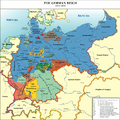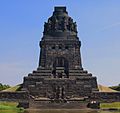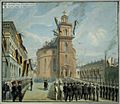Unification of Germany facts for kids
The process of the Unification of Germany occurred in the nineteenth century (1800–1900). Prior to unification, there were many states in Central Europe. Some of them were very small, possibly no more than 5 miles (8.0 km) from one border to the other. Many Germans wanted a nation that was united, powerful, and influential.
Unification took place on 18 January 1871. At the conclusion of the Franco-Prussian War, the German princes proclaimed the German nation in Versailles, France, at the Hall of Mirrors. Unification joined together the many independent German states. These states became the German Empire. Otto von Bismarck, Prime Minister of Prussia, became Chancellor of the Empire.
The unification of Germany began many years earlier, during the Napoleonic Wars. At the Battle of Leipzig in 1813, which is also called the Battle of Nations, many of the German states joined with Russia, Sweden, and Austria to defeat Napoleon's army. Later, in 1815, the Congress of Vienna ended the Napoleonic Wars. Austria remained the most politically powerful of the German states. Prussia emerged as Austria's political and diplomatic rival.
There were many problems in unifying the German states. Not all politicians were in favor of unification. Some feared that unification would give Austria and Prussia too much power among the many states. There were also problems in deciding who would collect taxes, and how much tax would be paid.
Background
Before the creation of the modern German State, there were hundreds of small duchies and kingdoms. Many of these kingdoms were a part of the Holy Roman Empire. In 800 AD, Pope Leo III made the Frankish King, Charlemagne, the Holy Roman Emperor.
In the 18th century the hundreds of rulers of parts of the Holy Roman Empire were practically independent; they seldom had to obey the Emperor, and often made war against each other or against the Emperor. During the Napoleonic Wars the empire was abolished. Napoleon made a new satellite state, the Confederation of the Rhine. He was soon defeated and the Congress of Vienna reorganized the German states into a new German Confederation. Bismarck's North German Confederation replaced that, until he converted it into the German Empire.
Images for kids
-
The German Empire from 1871–1918
-
Map of the Holy Roman Empire in 1789. The map is dominated by the Habsburg Monarchy (orange) and the Kingdom of Prussia (blue), besides a large number of small states (many of them too small to be shown on the map).
-
This depiction of Germania, also by Philipp Veit, was created to hide the organ of the Paul's Church in Frankfurt, during the meeting of the Parliament there, March 1848–49. The sword was intended to symbolize the Word of God and to mark the renewal of the people and their triumphant spirit.
-
The convergence of leadership in politics and diplomacy by Bismarck, left, reorganization of the army and its training techniques by Albrecht von Roon (center), and the redesign of operational and strategic principles by Helmuth von Moltke (right) placed Prussia among the most powerful states in European affairs after the 1860s.
-
From north to south: The Danish part of Jutland in purple and terracotta, Schleswig in red and brown, and Holstein in lime yellow. The Schleswig-Holstein Question was about the status of those territories.
-
Emperor Napoleon III (left) at Sedan, on 2 September 1870, seated next to Prussian Chancellor Otto von Bismarck, holding Napoleon's surrendered sword. The defeat of the French army destabilized Napoleon's regime; a revolution in Paris established the Third French Republic, and the war continued.
-
18 January 1871: The proclamation of the German Empire in the Hall of Mirrors at the Palace of Versailles. Bismarck appears in white. The Grand Duke of Baden stands beside Wilhelm, leading the cheers. Crown Prince Friedrich, later Friedrich III, stands on his father's right. Painting by Anton von Werner
-
Monument to Kaiser Wilhelm, at Koblenz, where the Moselle River (upper river) meets the Rhine River (lower river), called the Deutsches Eck, or the German corner.
See also
 In Spanish: Unificación alemana para niños
In Spanish: Unificación alemana para niños















